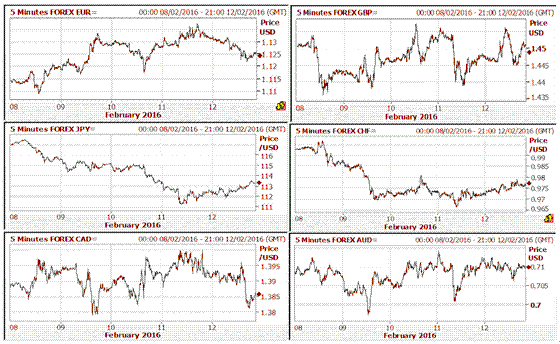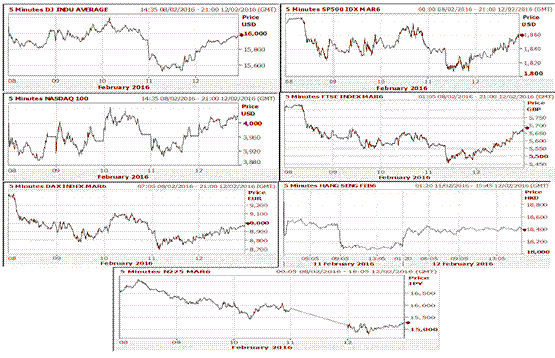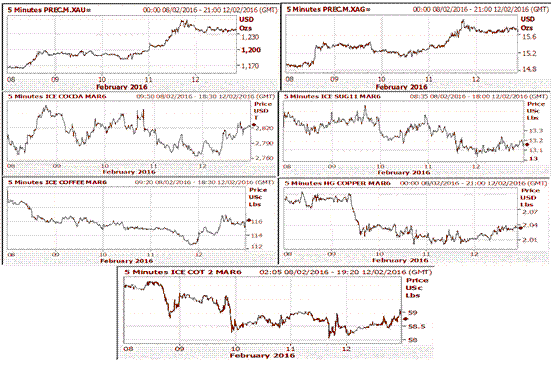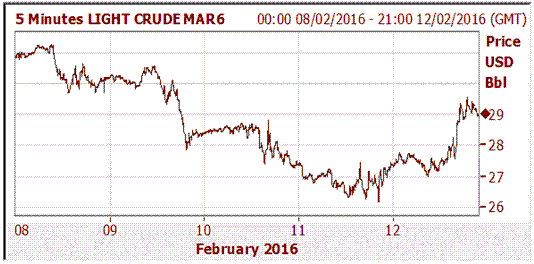FOREX
Forex – The yen surged by half a percent against the dollar on Monday as worry over Europe's banks drove capital to the safety of the Japanese currency. A recovery in oil prices early in European trade quickly gave way to another bout of the selling that has dominated the first month of 2016 on major stock and commodity markets. The euro - until now also considered a safe haven for investors, fell almost 1 percent against the yen as European bank shares fell and the cost of insuring debt against default jumped. It also fell 0.4 percent against the dollar. But with the market abandoning bets that U.S. interest rates would rise this year, the dollar remains under pressure.
The dollar languished close to a 3-1/2-month low against a basket of major currencies on Wednesday, as traders waited for U.S. interest rate guidance from Federal Reserve Chair Janet Yellen. The currency has shed over 3 percent over the past two weeks as expectations of a 2016 rate rise have all but vanished. In times of economic stress, countries or regions running current account surpluses, as are Japan, the euro zone and Switzerland, are seen as safer compared with those that have deficits and rely on foreign capital to finance the gap. The United States, UK and Australia fall into the latter category. That explains why the euro has been supported despite surprisingly weak German industrial output data and a sell-off of European bank shares.
The dollar nursed losses on Friday that have put it on course for steep weekly drops against major currencies, with many investors favouring the perceived safe-haven appeal of the yen amid sinking global markets. Japanese markets were closed for a public holiday on Thursday, when the dollar fell to its lowest level since October 2014. The euro edged down 0.1 percent on Friday, but was not far from its overnight high. It was on track for a weekly gain of 1.3 percent. The dollar index, which gauges the U.S. unit against a basket of six major currencies, inched about 0.1 percent higher to 95.666, poised for a 1.4 percent weekly loss, after skidding to a low of 95.236 overnight, its lowest since October.
INDICES
Indices - Stock indexes worldwide tumbled on Monday, led by banking stocks in Europe and technology stocks on Wall Street on persisting fears of a global economic slowdown, while benchmark 10-year Treasury yields hit their lowest in a year on demand for assets deemed less risky. European shares extended the previous week's big losses, with the FTSEuro first 300 index of top regional shares closing at its lowest level since Oct. 2013. Wall Street continued Friday's technology-led selloff, with the benchmark S&P 500 stock index falling as much as 2.5 percent. The S&P financial index fell more than 3 percent, with Bank of America, JPMorgan and Citigroup dragging down the index.
Most U.S. shares ended little changed to lower on Wednesday, erasing early gains on concerns about global growth and sliding commodity-related shares, while greater calm surrounding the European banking sector boosted that region's shares. The benchmark U.S. S&P 500 stock index rose as much as 1.6 percent following Federal Reserve Chair Janet Yellen's prepared testimony to Congress. It changed course and ended mostly flat, while the Dow Jones industrial dropped down for the day. Yellen acknowledged that tightening financial conditions and uncertainty about China posed risks, but told Congress she does not expect the central bank to reverse its rate hike program.
U.S. and European shares rebounded from recent weakness on Friday, with reassuring U.S. retail sales data boosting sentiment, while U.S. crude prices rallied from more than 12-year lows. Banking shares in the United States and Europe spiked, with the S&P financial index closing up 4 percent and the STOXX 600 Europe Banks index gaining 5.6 percent. The U.S. S&P 500 gained about 2 percent after five days of losses that had dropped it to its lowest level in two years on Thursday, but still posted its second straight weekly decline. Japan's Nikkei, which was closed for a public holiday during Thursday's global rout, fell 5.4 percent, but there was relief elsewhere as the dollar's brutal fall against the yen this week petered out and commerce department data showing U.S. retail sales excluding automobiles, gasoline, building materials and food services increased 0.6 percent in January also boosted optimism.
COMMODITIES
Commodities - The price of gold jumped more than 2 percent on Monday to touch its highest level since June, extending last week's sharp gains, as sliding stock markets and worries over global economic growth prompted investors to seek safety in hard assets. Gold has now risen more than 12 percent since the start of 2016, reversing last year's 10.4 percent loss. Gold prices stabilized below a 7-1/2-month high on Wednesday after U.S. Federal Reserve Chair Janet Yellen stated that only gradual adjustments to monetary policy were likely and stressed that global headwinds could hurt U.S. growth. In her first testimony to Congress since the December rate hike, Yellen said that tightening financial conditions and uncertainty over China pose risks to the U.S. recovery, but chances are slim the Fed would need to reverse the rate tightening cycle. Gold took a breather on Friday after soaring 4 percent the previous day but was still set for its best week in four years after stock market turmoil sent investors into safe haven assets. Gold has benefited along with bonds and the Japanese yen from a rush to safety as investors worry about the health of some banks and the risk of a possible global recession. They have been unnerved since the Bank of Japan, followed by Sweden this week, introduced negative interest rates to try and stimulate growth and now worry that if economic conditions deteriorate sharply the U.S. Federal Reserve might have to cut rates rather than raise them.
Cocoa futures on ICE surged more than 3 percent in heavy volume on Monday as concerns about weather in West Africa spurred short-covering, while coffee prices tumbled on weak economic sentiment that weighed on larger commodity markets. Sugar futures rose for the second straight day, putting further distance from last week's four-month low, but the move caused the March/May spread SBH6-K6 to weaken. Sugar futures on ICE pared losses on Wednesday, after earlier pressure from the weak Brazilian currency and expectations for a vast 2016/17 crop there, while dealers focused on a likely moderate March white sugar delivery. Coffee and cocoa futures were mixed as the market awaited new fundamentals. Sugar futures settled down 0.1 percent per lb. Coffee futures rallied in heavy volume on Friday, buoyed by strength in other commodity markets and options-related short covering that briefly pushed the March/May spread to an 11 month high, but the market posted a weekly loss.
Henyep Investment (UK) Ltd is a company of the Henyep Financial Group and is authorised and regulated by the Financial Conduct Authority (FCA).
ENERGY
Crude Oil - Global oil markets fell 3 percent to settle down for a third straight day on Monday on worries that U.S. crude stockpiles had reached new record highs, while a Saudi-Venezuela meeting to boost prices showed little progress. Oil was also hurt by tumbling U.S. equity markets amid persistent fears about the global economic slowdown. U.S. commercial crude oil inventories, already brimming at record high levels, were forecast to be a positive figure.
However, on Wednesday, U.S. crude rose above $29 a barrel after government data showed crude inventories in the country unexpectedly fell by 754,000 barrels in the latest week due to lower imports. Analysts had expected a rise of 3.6 million barrels.
Global oil prices surged as much as 12 percent on Friday after a report once again suggested OPEC might finally agree to cut production to reduce the world glut, while a bounce in stock markets fed appetite for risk.
Despite the strong daily gain, oil prices were poised to end the week down as much as 5 percent. The United Arab Emirates' energy minister said the Organization of the Petroleum Exporting Countries was willing to cooperate on an output cut, as the Wall Street Journal reported on Thursday after crude futures settled in U.S. trade.
The information set forth herein was obtained from sources which we believe to be reliable, but its accuracy cannot be guaranteed. It is not intended to be an offer, or the solicitation of any offer, to buy or sell the products or instruments referred herein. Any person placing reliance on this commentary to undertake trading does so entirely at their own risk.
Recommended Content
Editors’ Picks
AUD/USD post moderate gains on solid US data, weak Aussie PMI

The Australian Dollar registered solid gains of 0.65% against the US Dollar on Thursday, courtesy of an upbeat market mood amid solid economic data from the United States. However, the Federal Reserve’s latest monetary policy decision is still weighing on the Greenback. The AUD/USD trades at 0.6567.
EUR/USD recovers to top end of consolidation ahead of Friday’s US NFP

EUR/USD drove back to the top end of recent consolidation on Thursday, recovering chart territory north of the 1.0700 handle as market risk appetite regains balance heading into another US Nonfarm Payrolls Friday.
Gold recoils on hawkish Fed moves, unfazed by dropping yields and softer US Dollar

Gold price clings to the $2,300 figure in the mid-North American session on Thursday amid an upbeat market sentiment, falling US Treasury yields, and a softer US Dollar. Traders are still digesting Wednesday’s Federal Reserve decision to hold rates unchanged.
Ethereum may sustain trading inside key range, ETH ETFs to be delayed until 2025

Ethereum is beginning to show signs of recovery on Thursday despite a second consecutive day of poor performance in Hong Kong's spot Ethereum ETFs. Bloomberg analyst James Seyffart has also shared that a spot Ethereum ETF may not happen in the US in 2024.
FOMC in the rear-view mirror – NFP eyed

The update from May’s FOMC rate announcement proved more dovish than expected, which naturally weighed on the US dollar (sending the DXY to lows of 105.44) and US yields, as well as, initially at least, underpinning major US equity indices.



